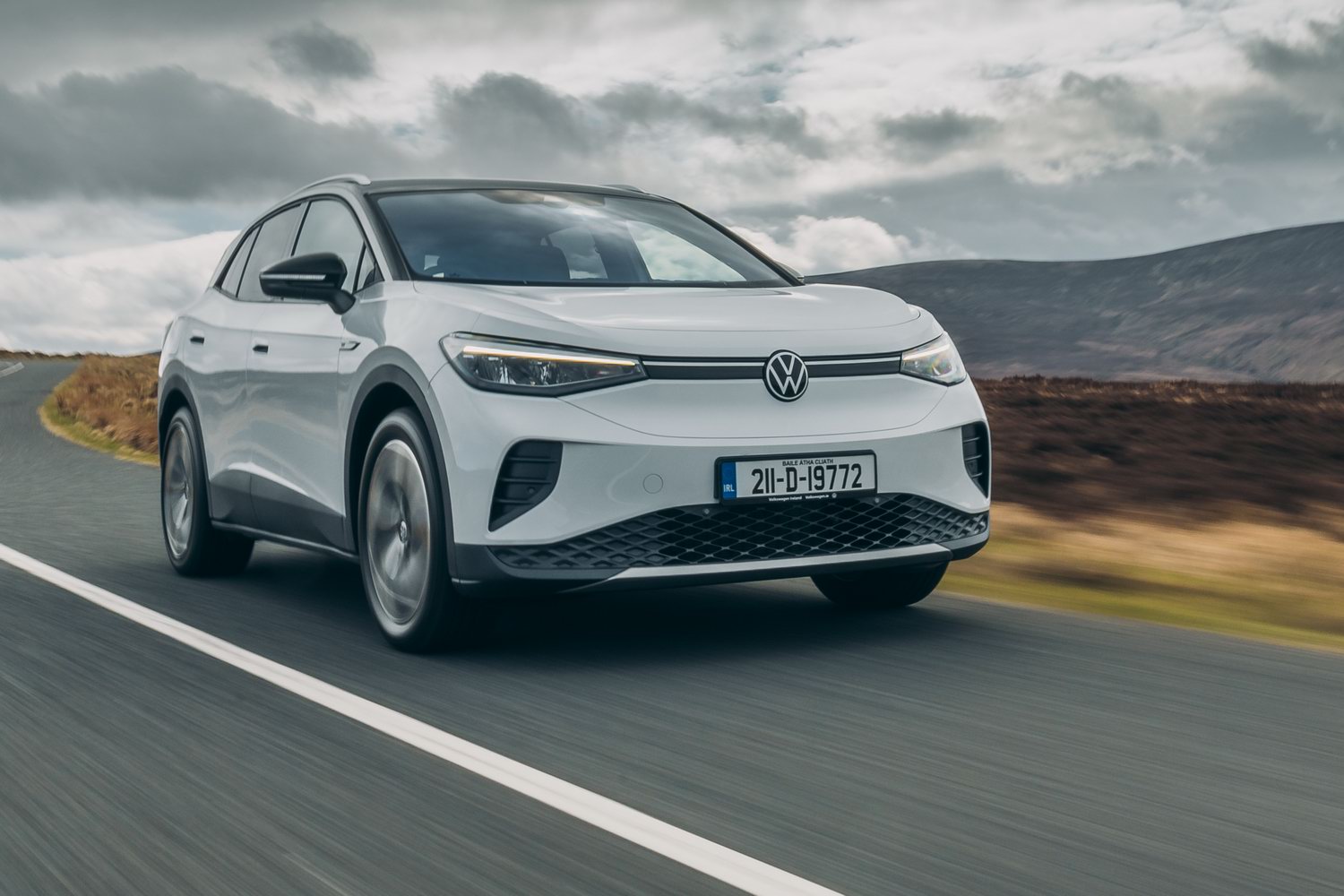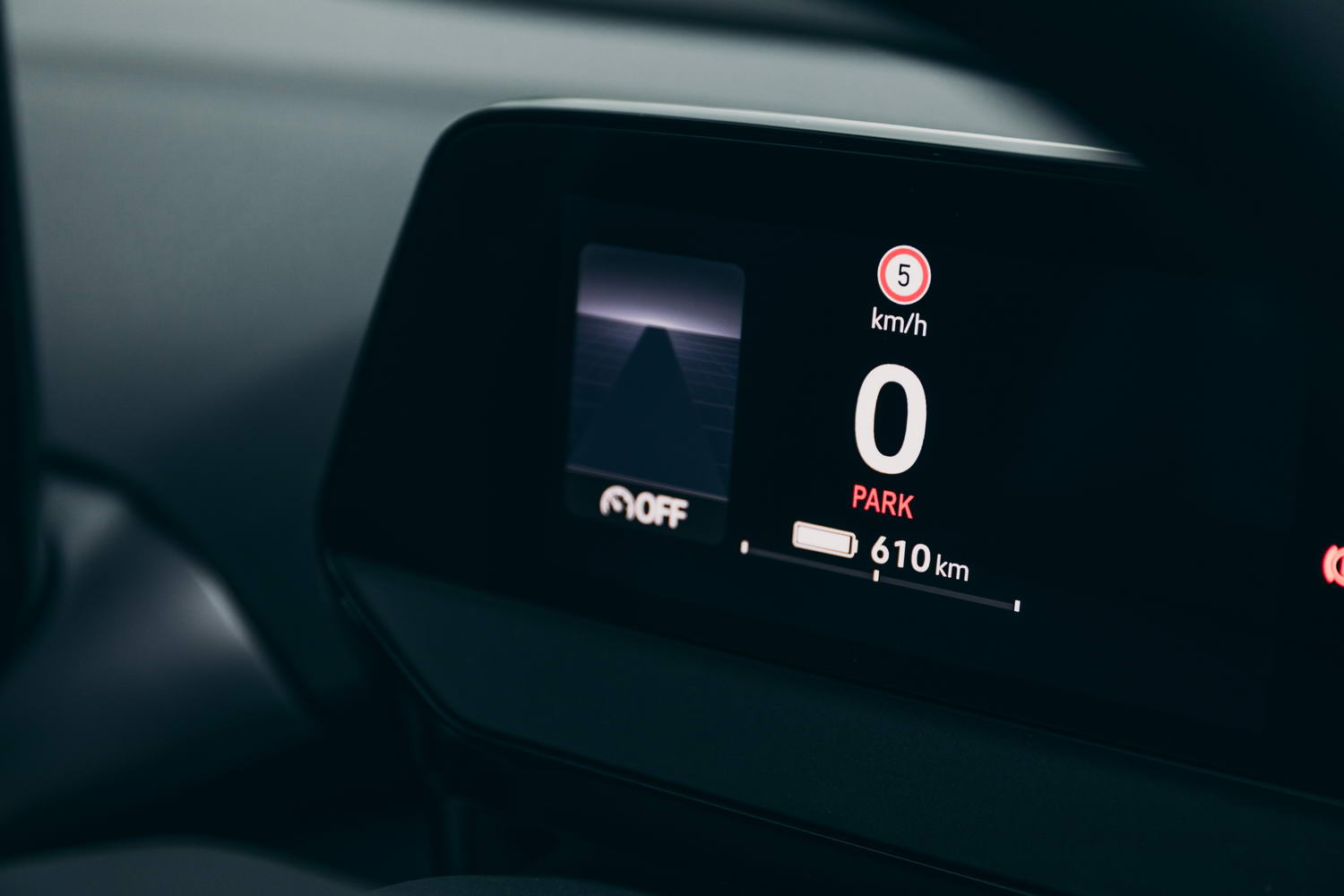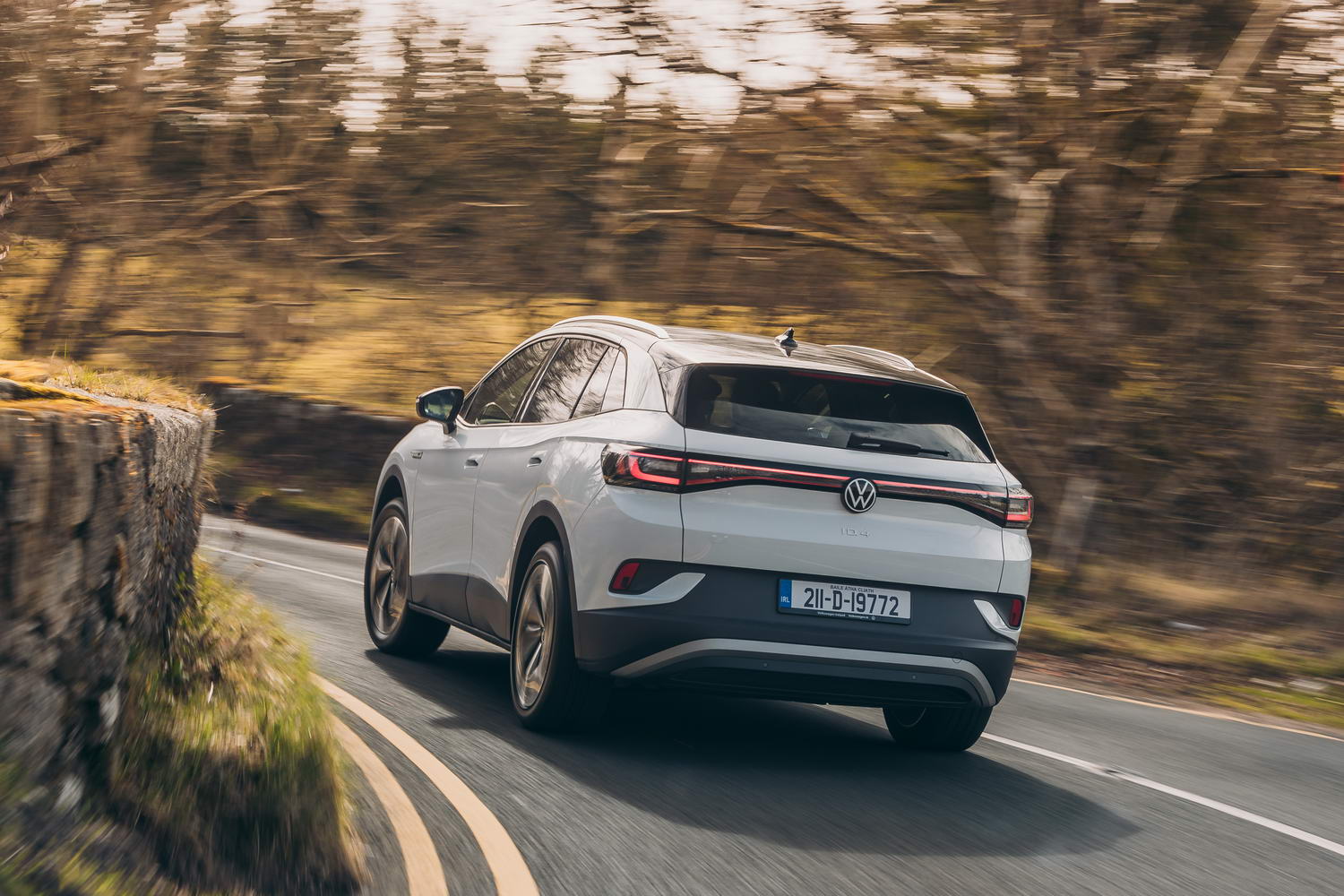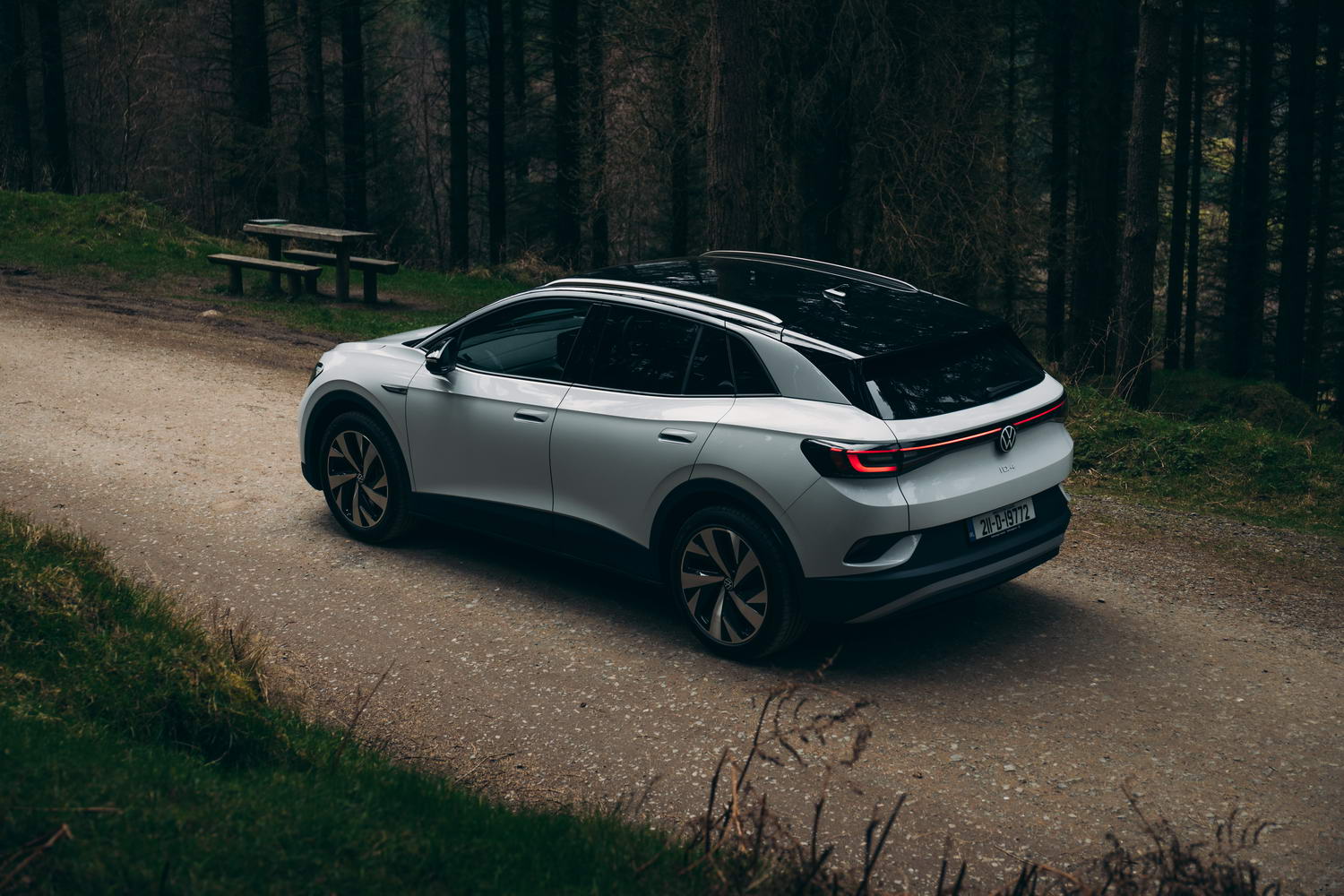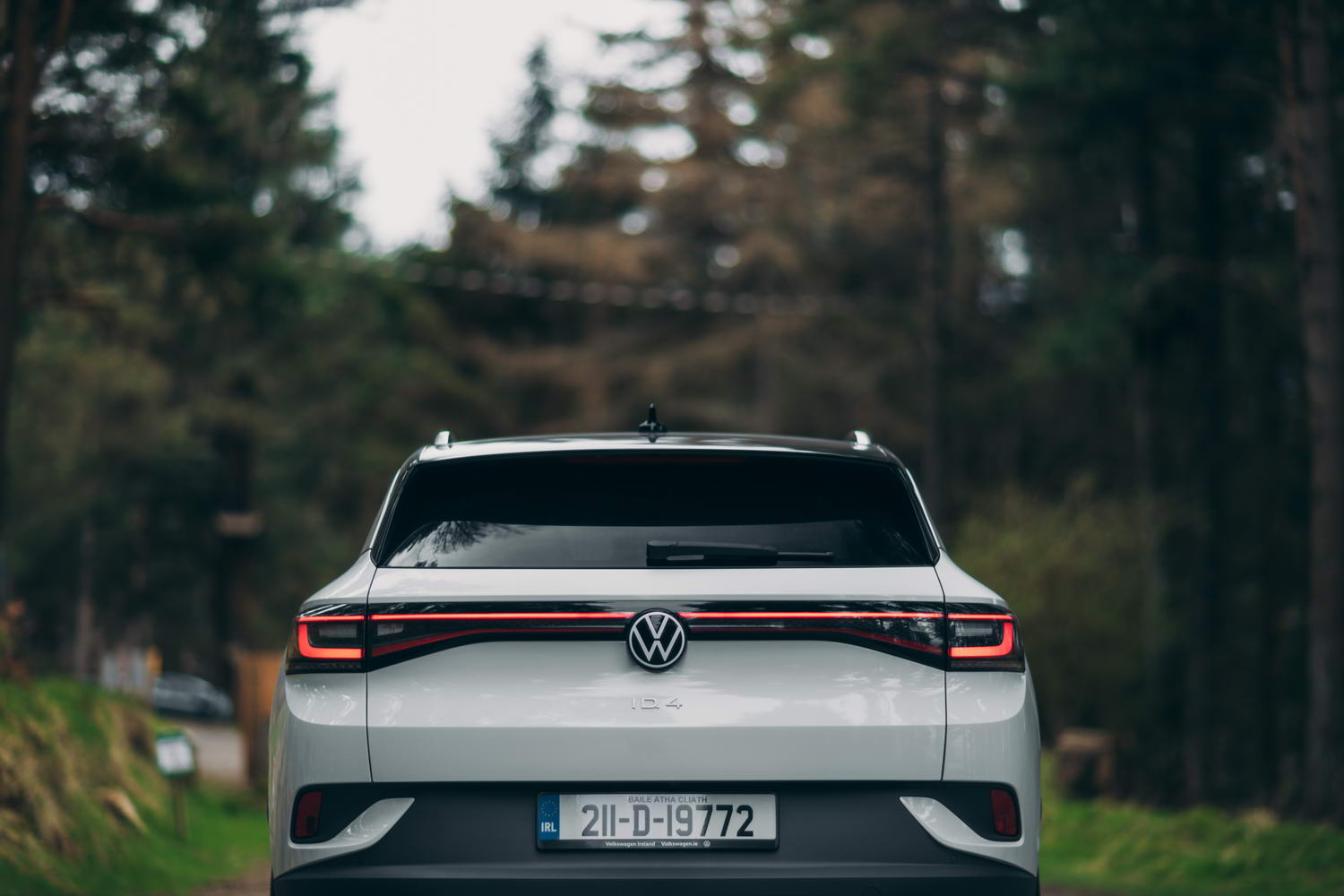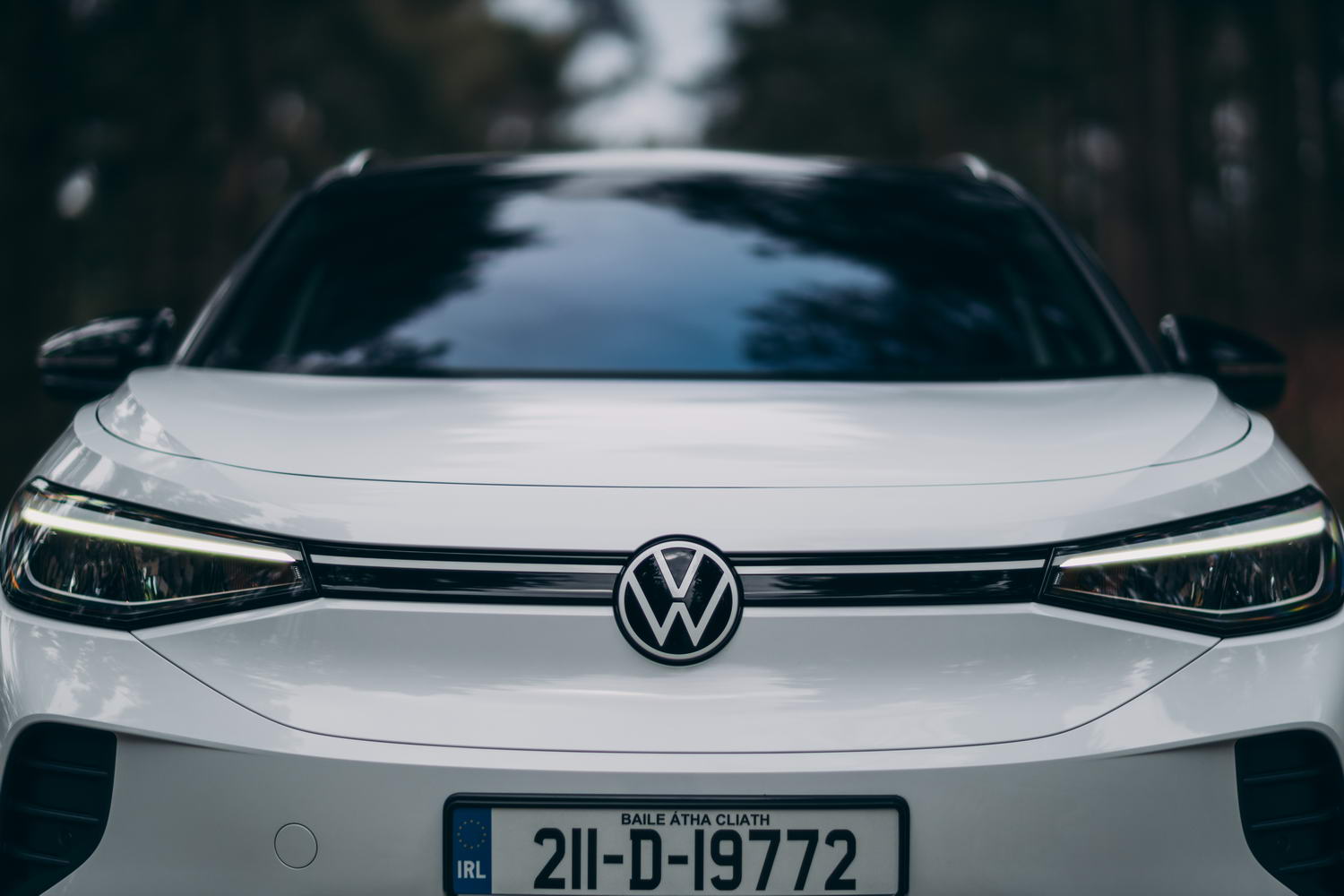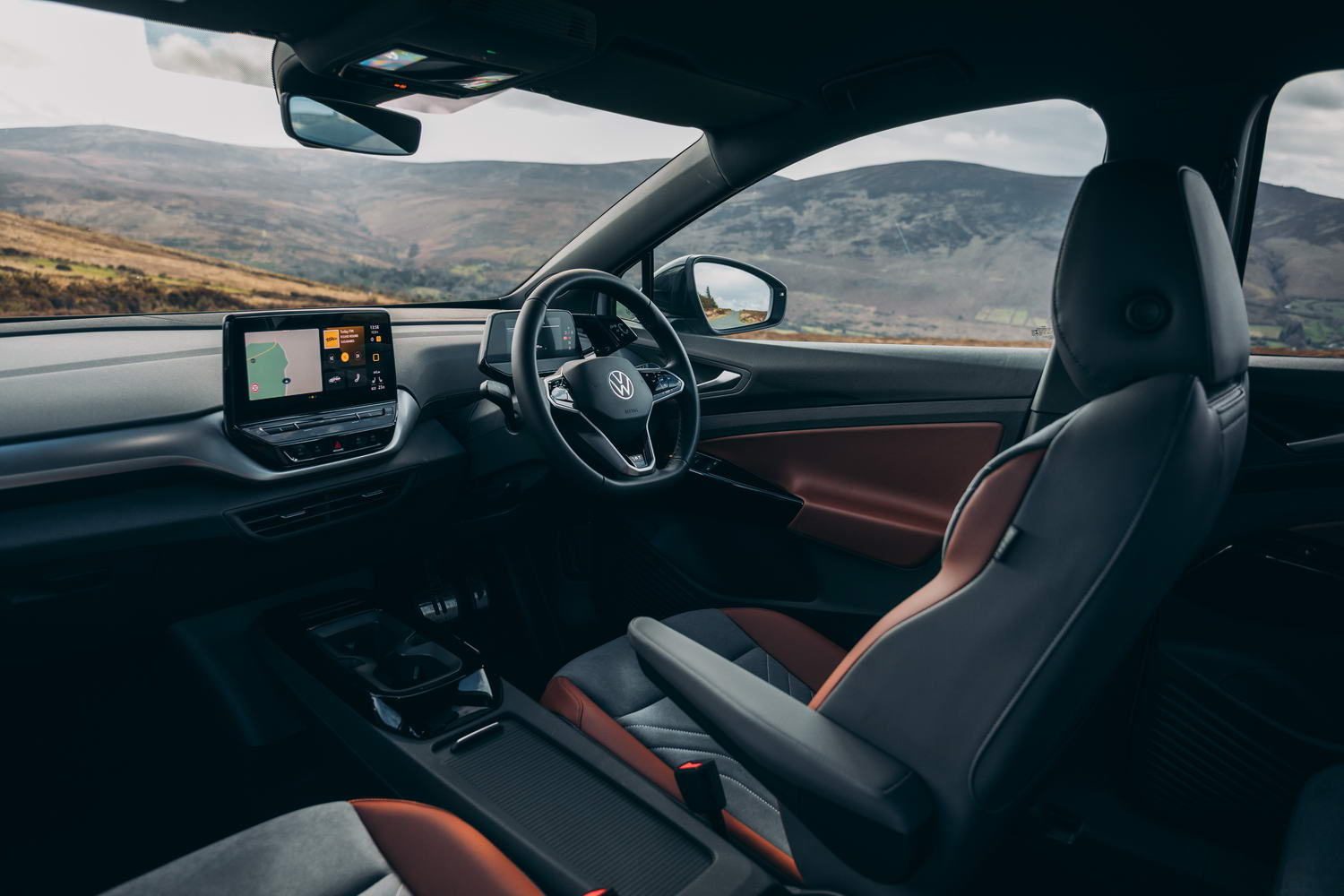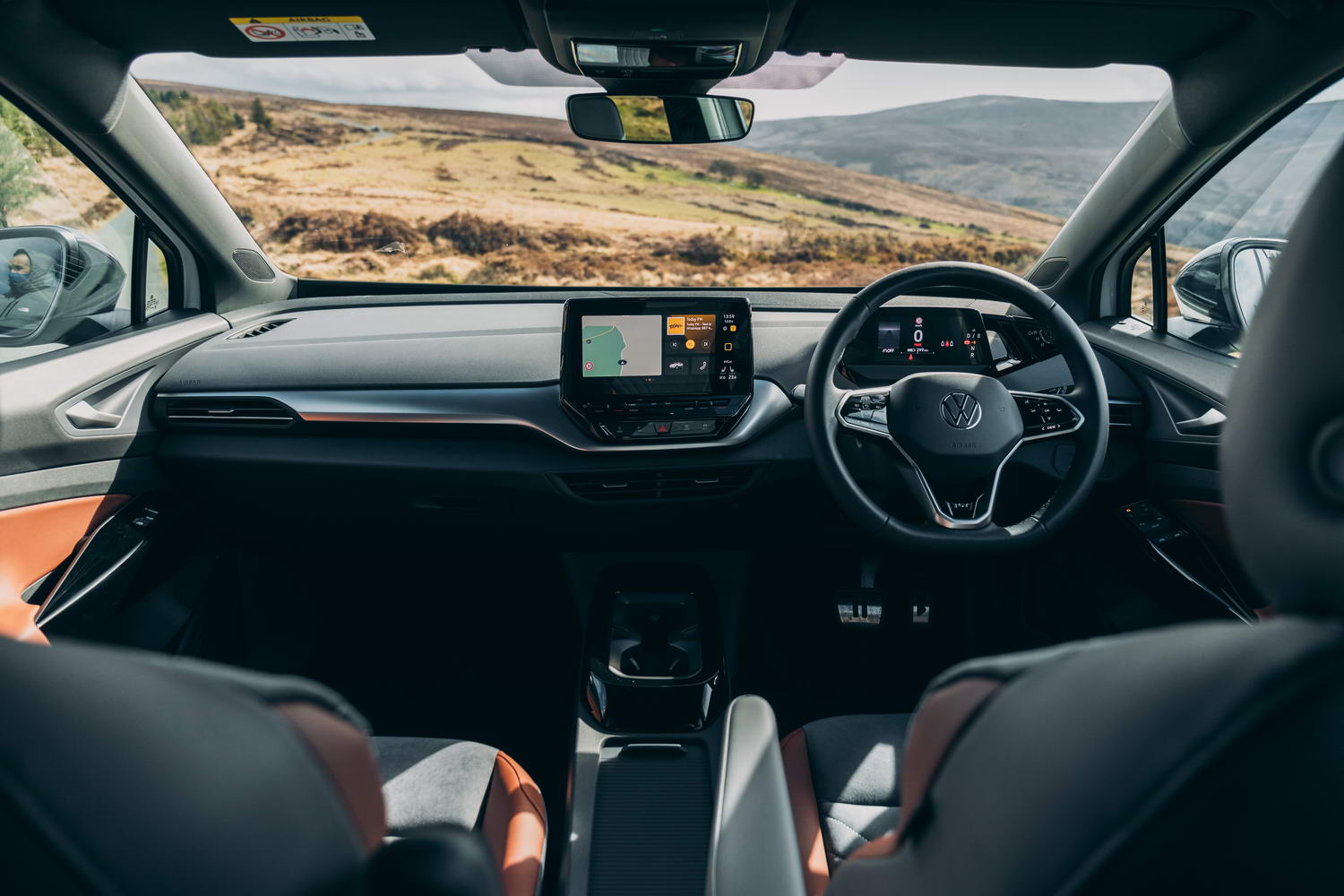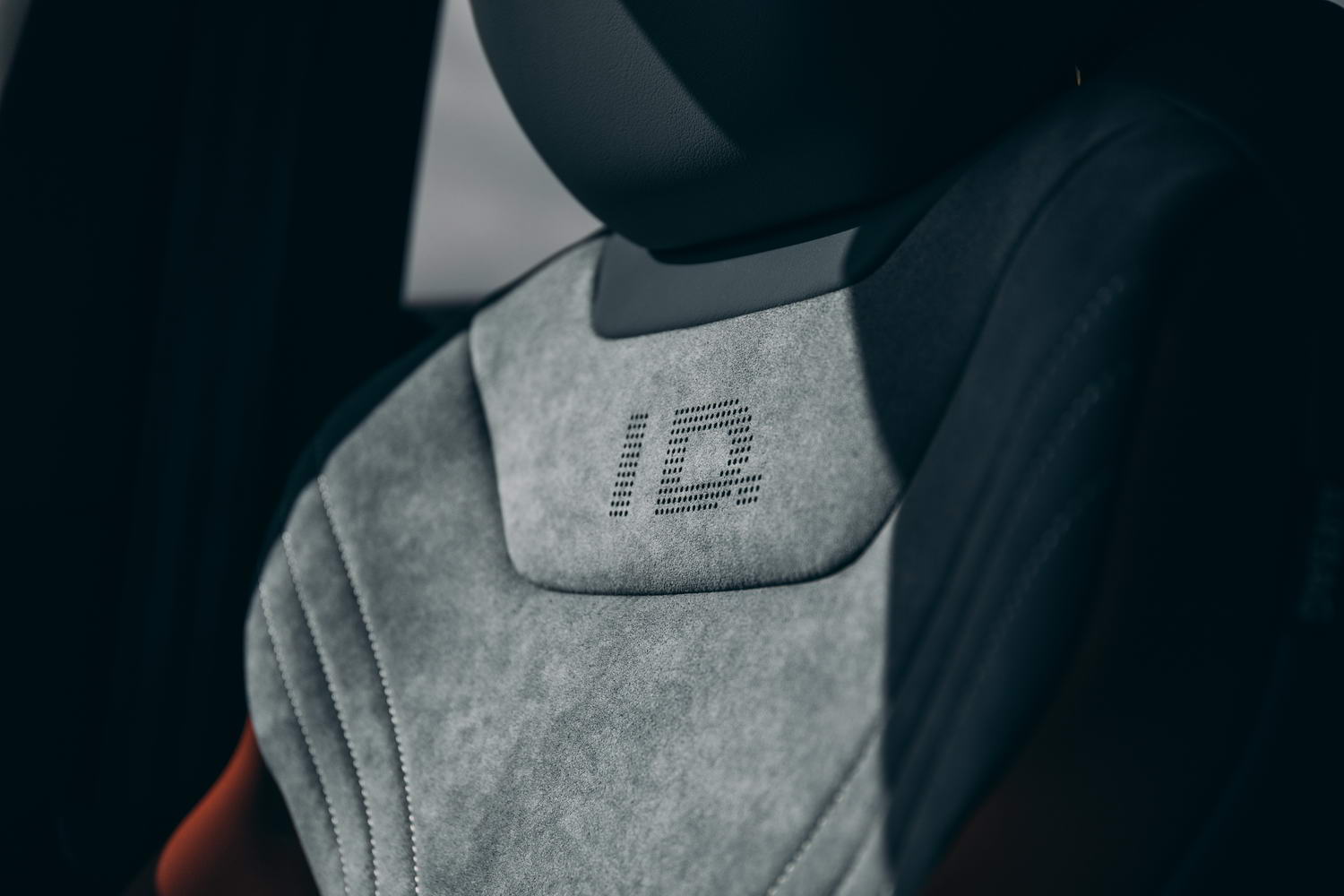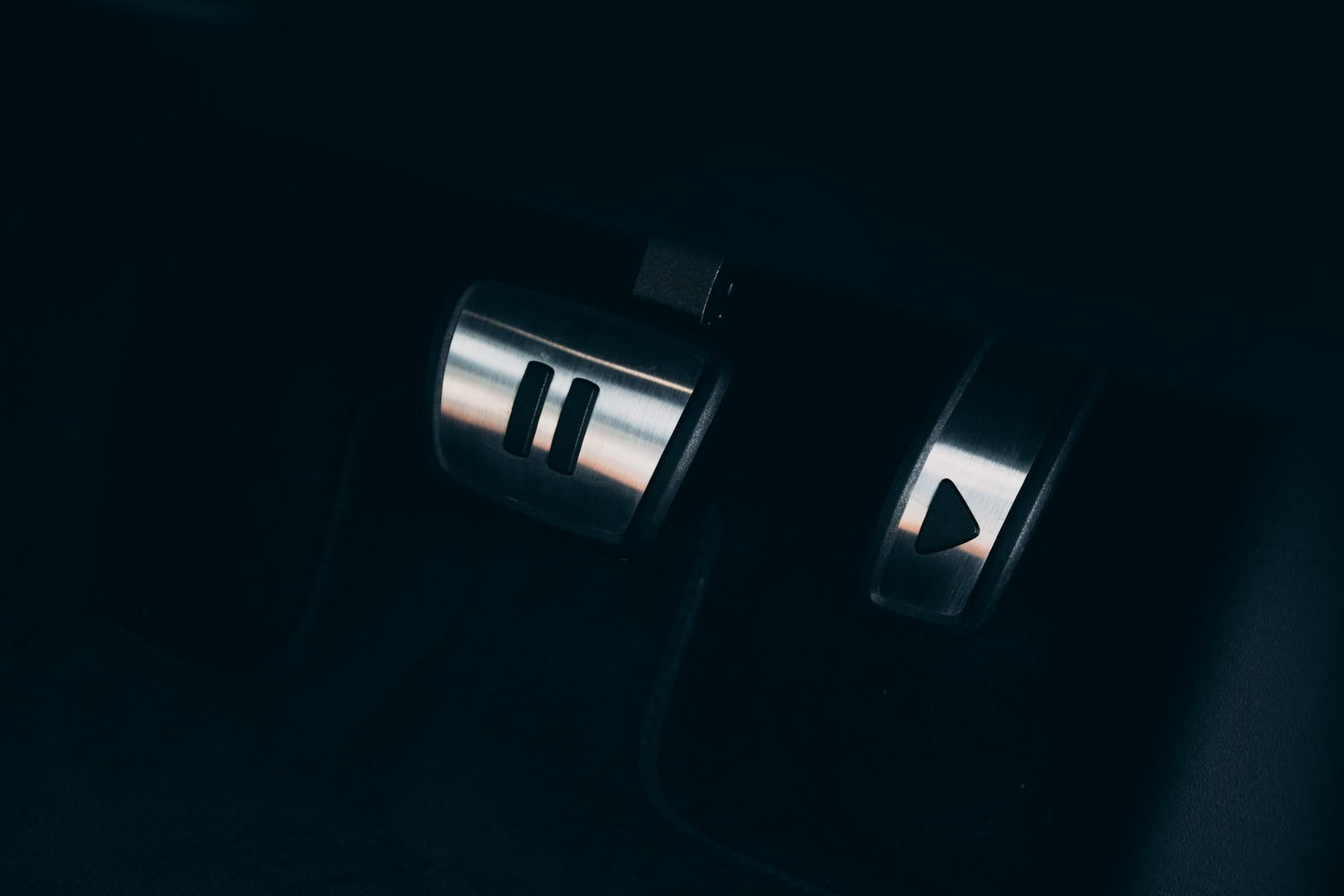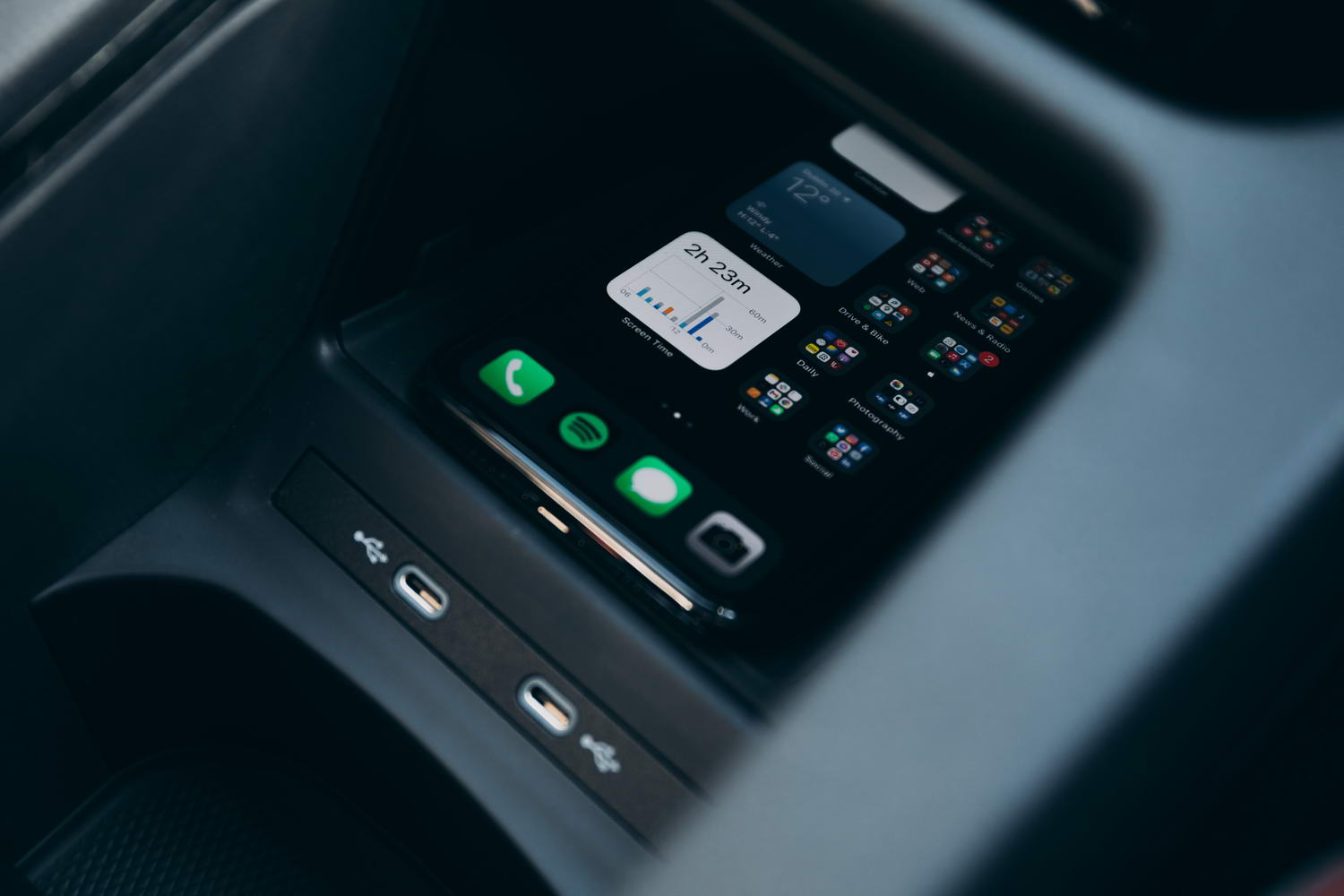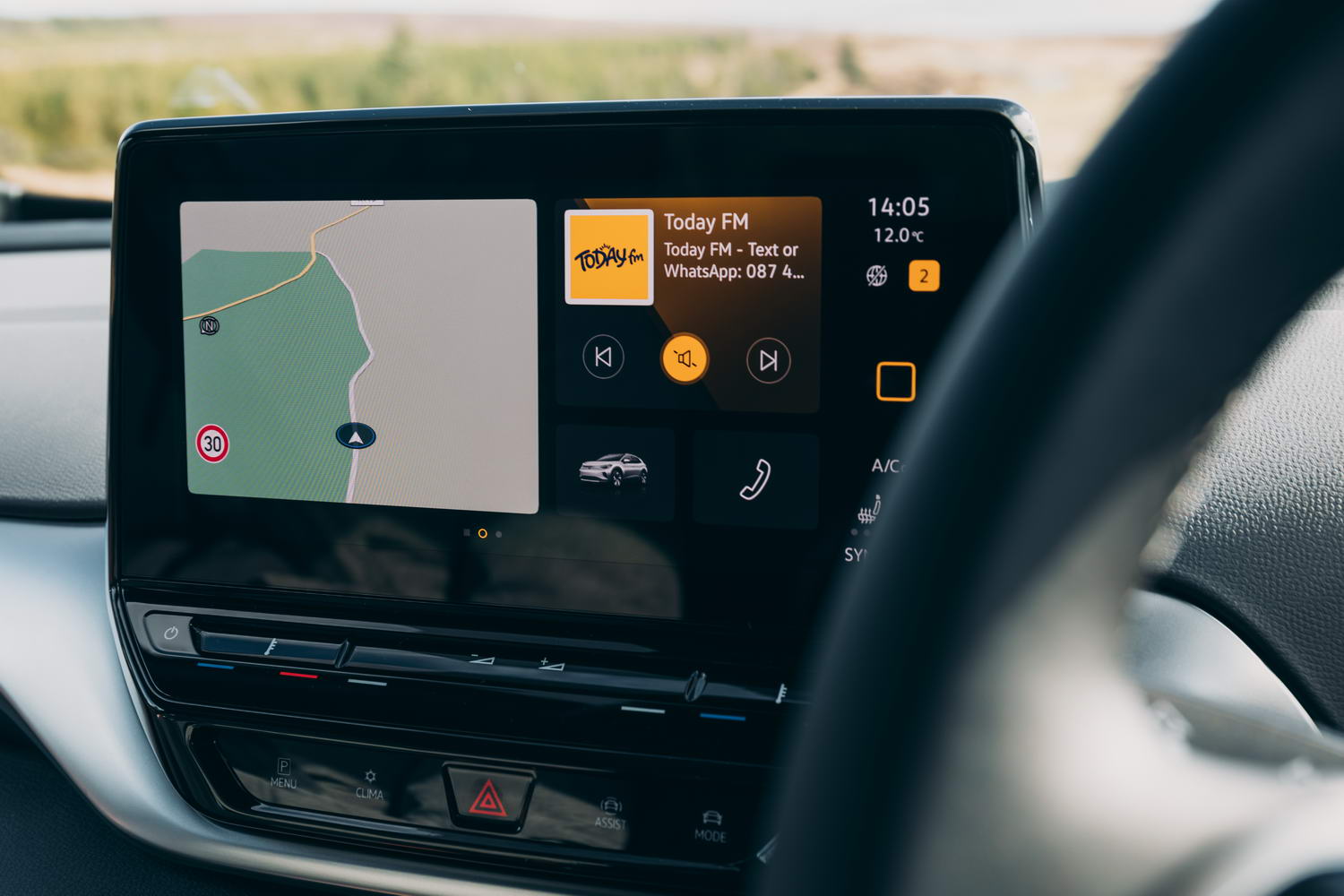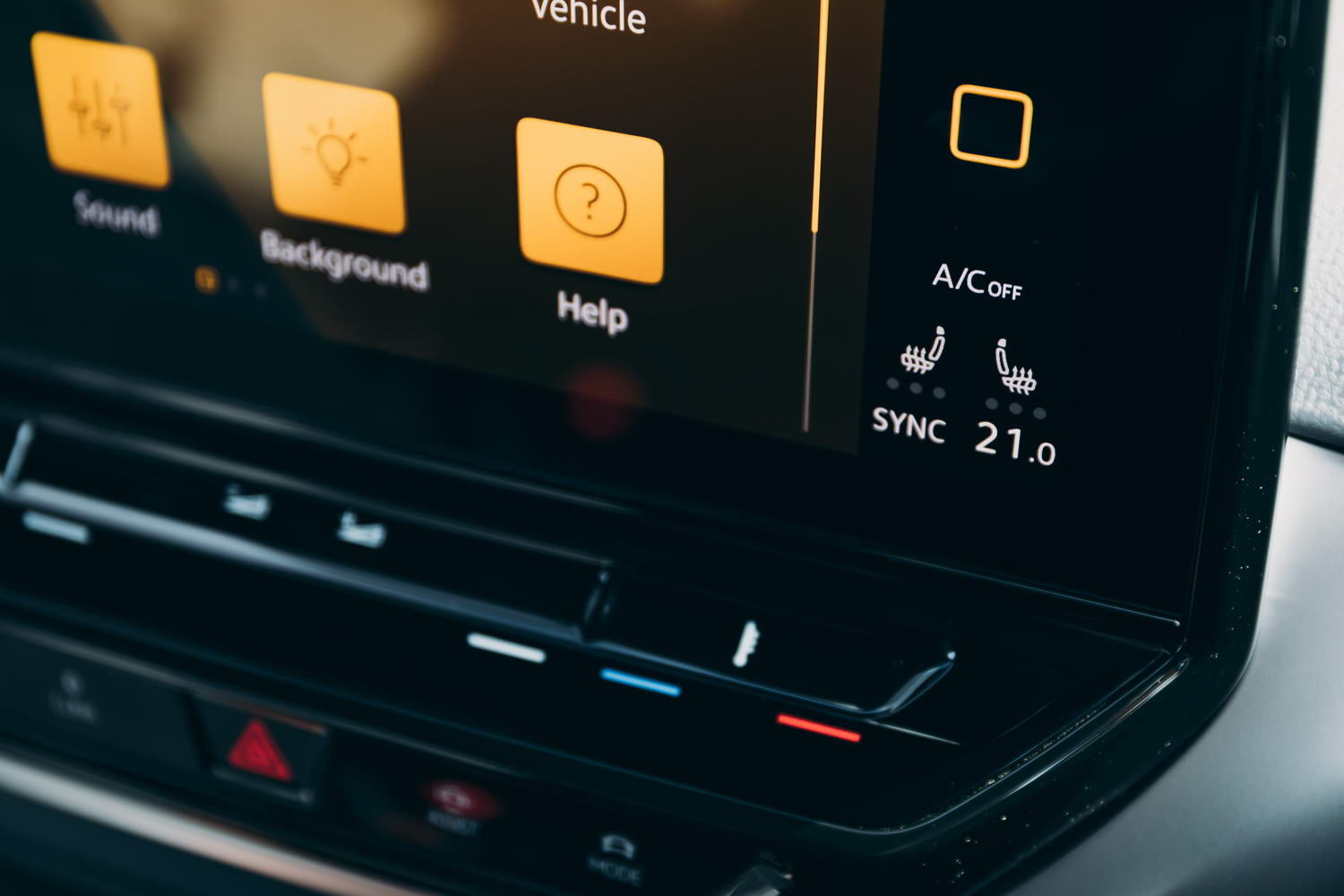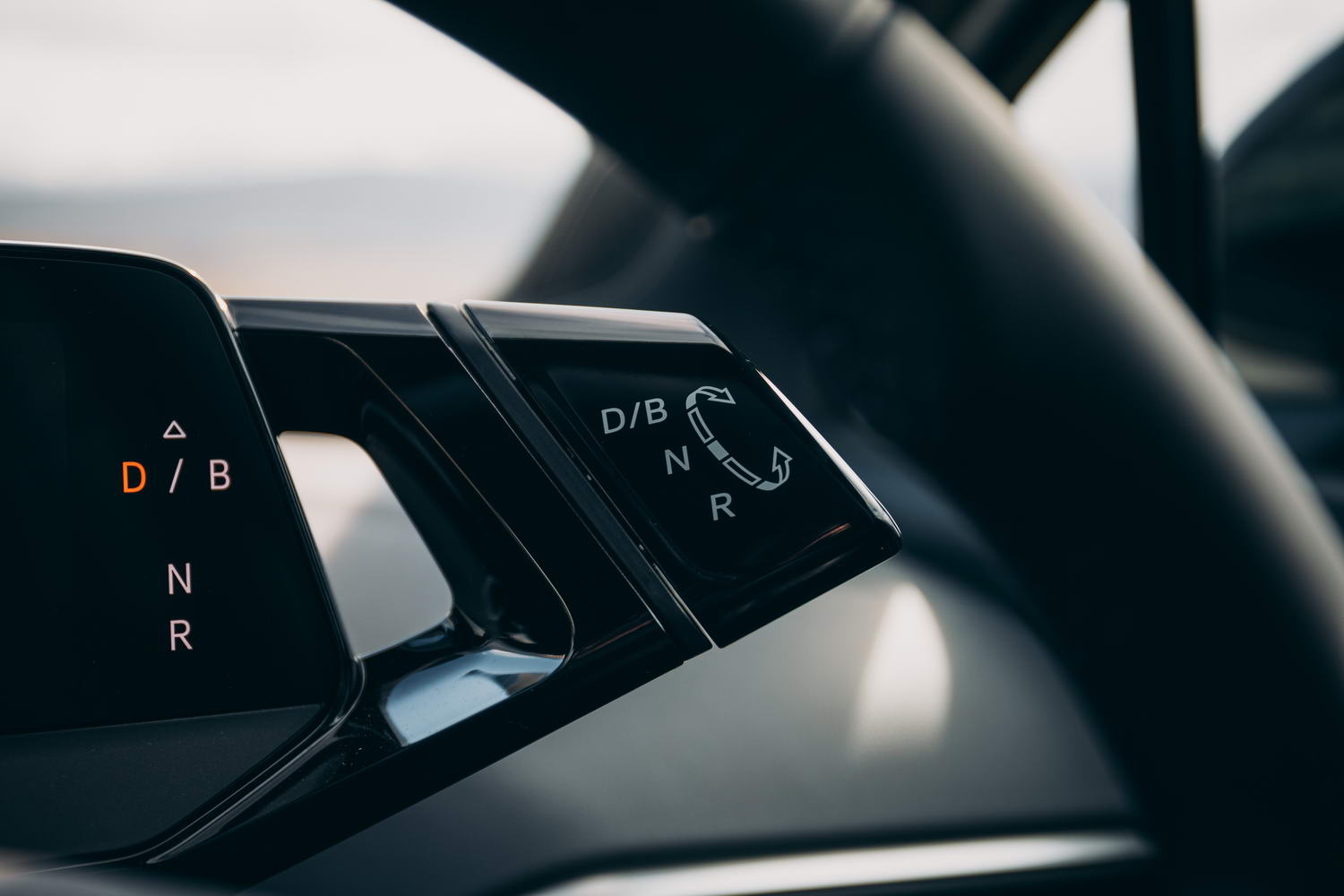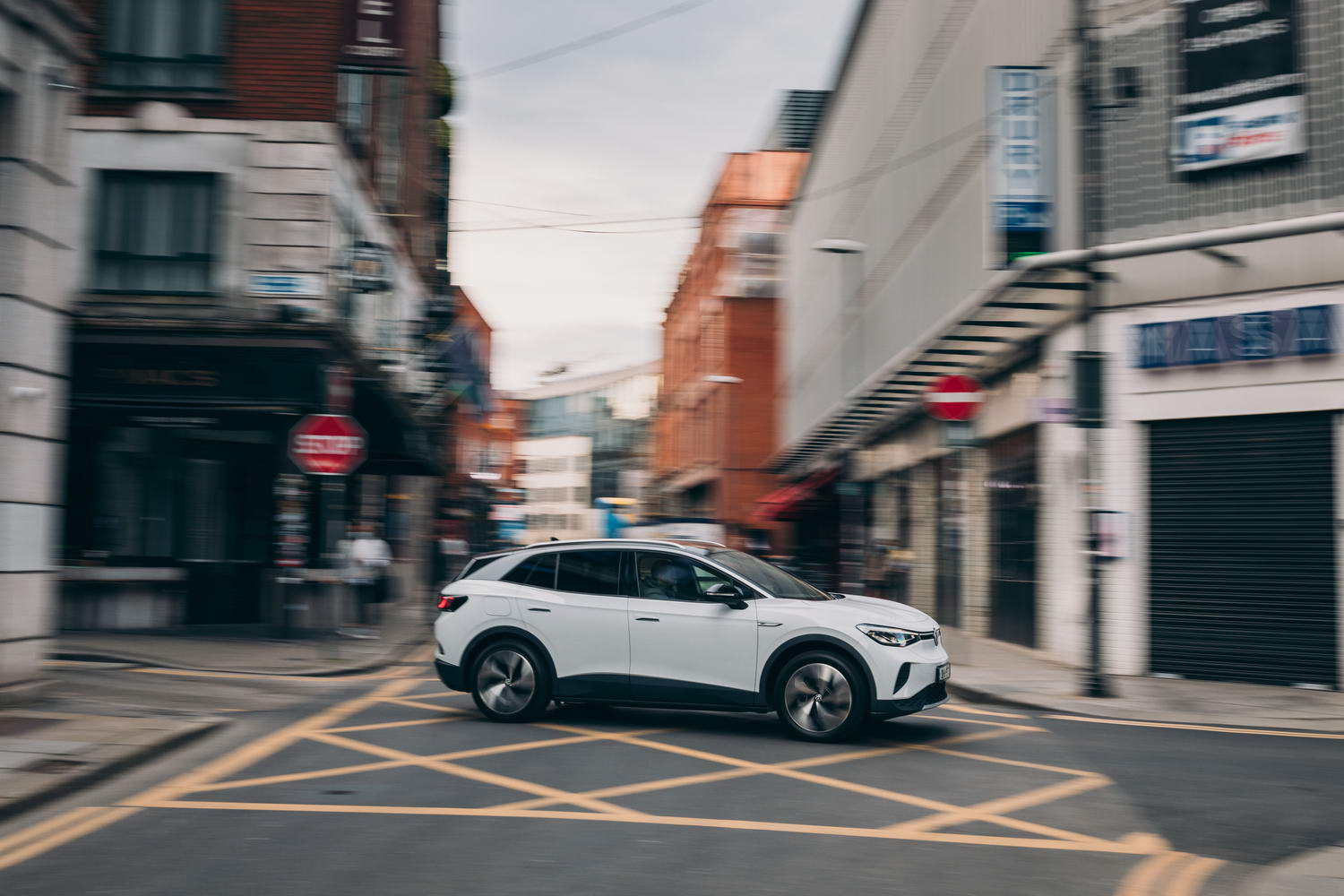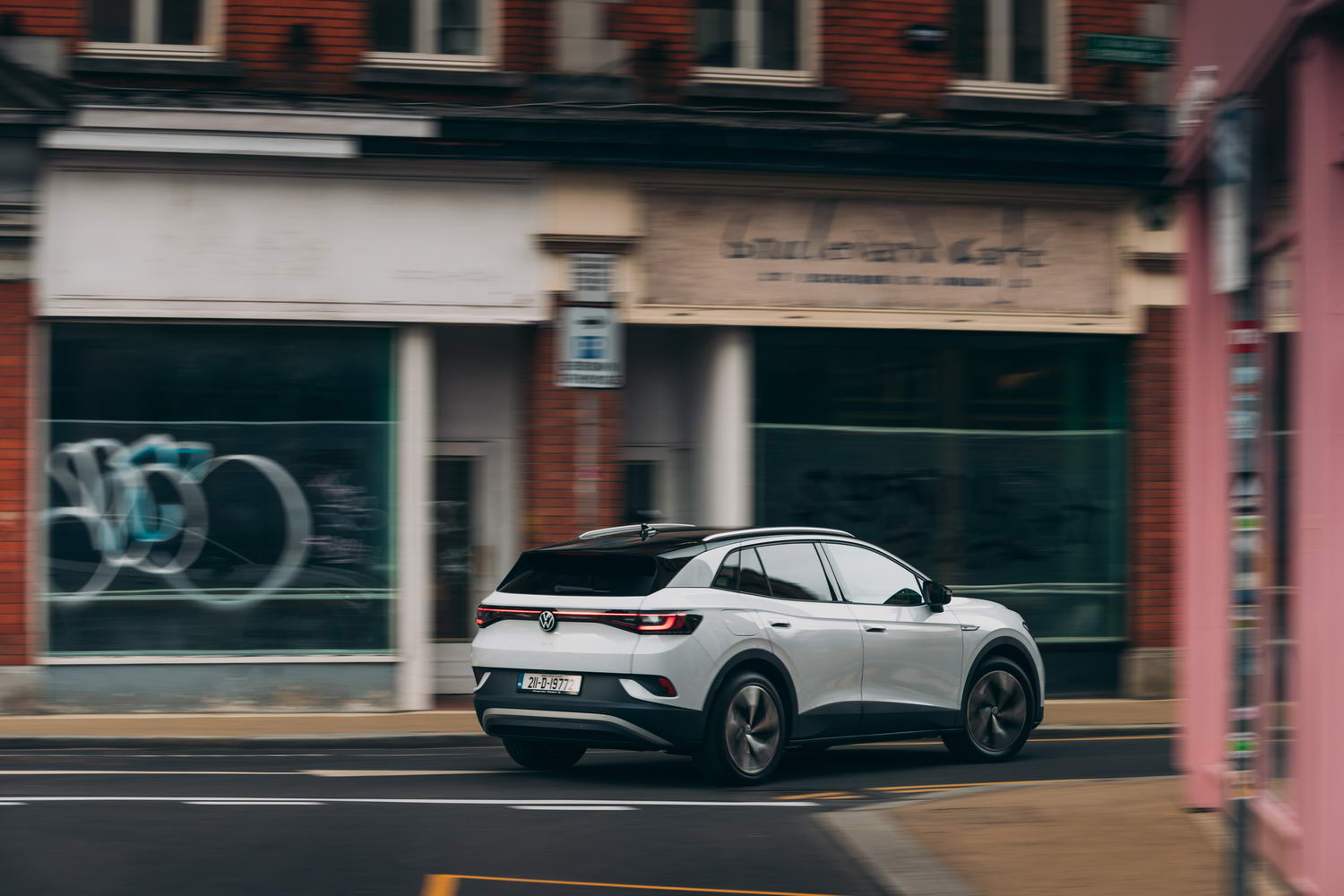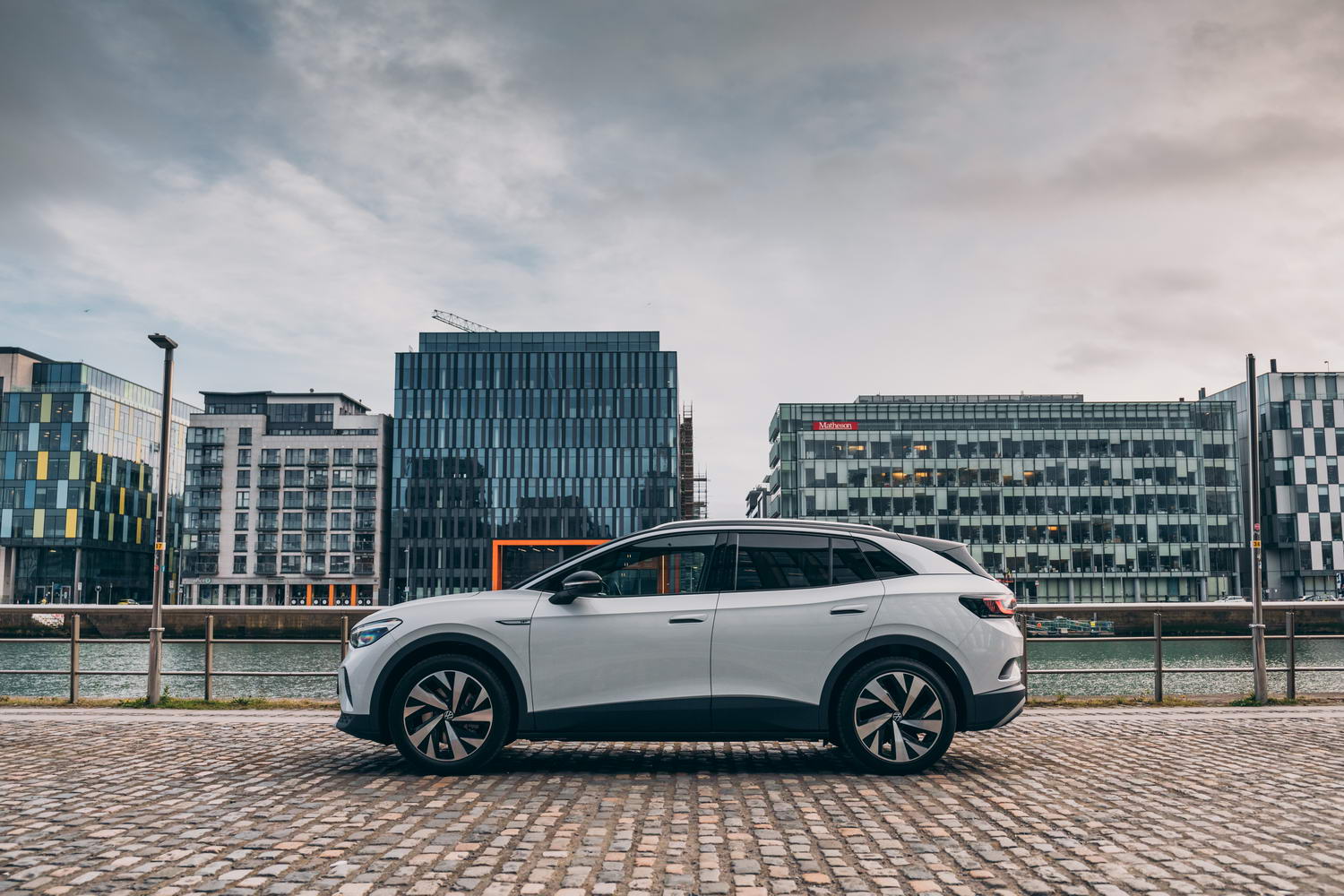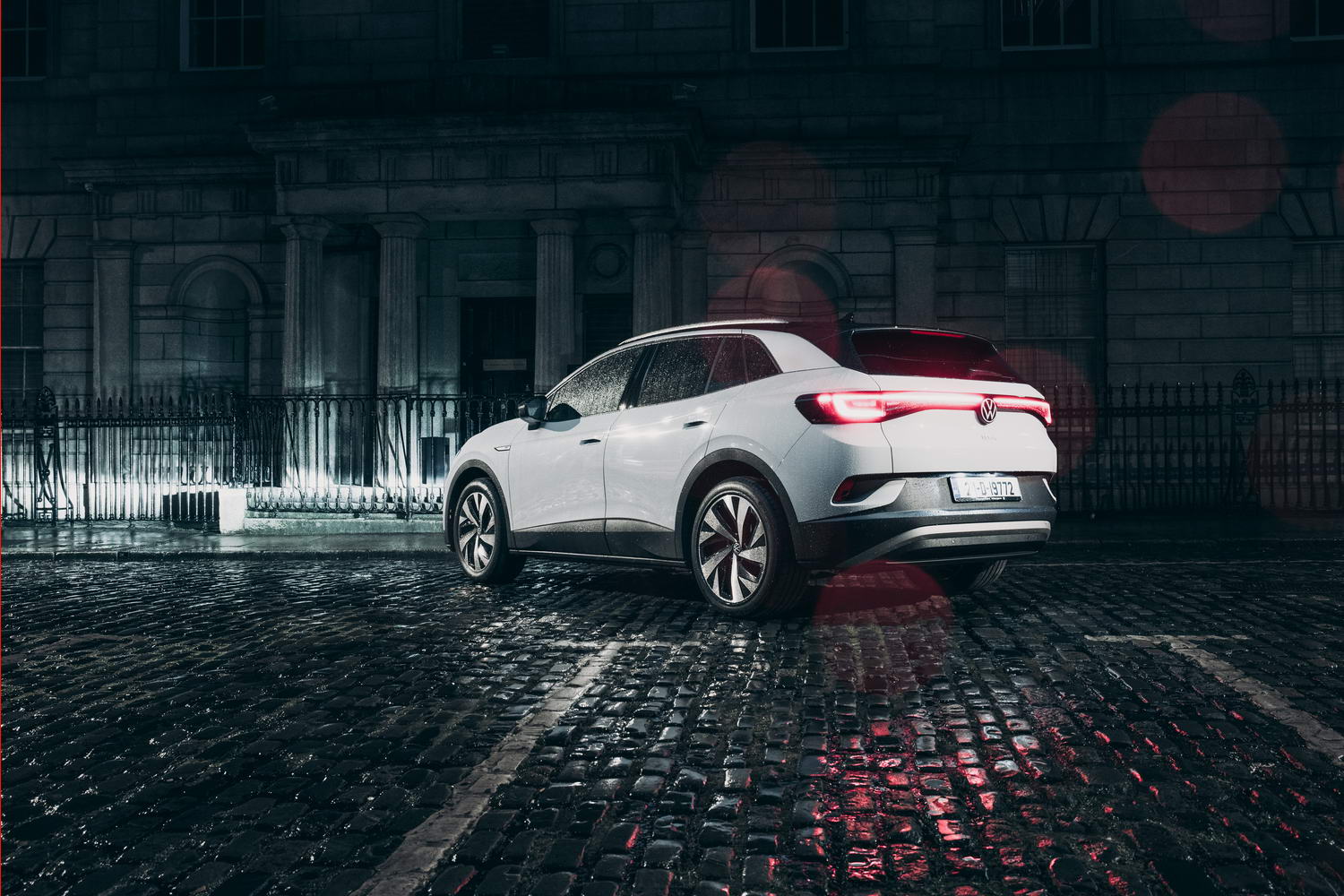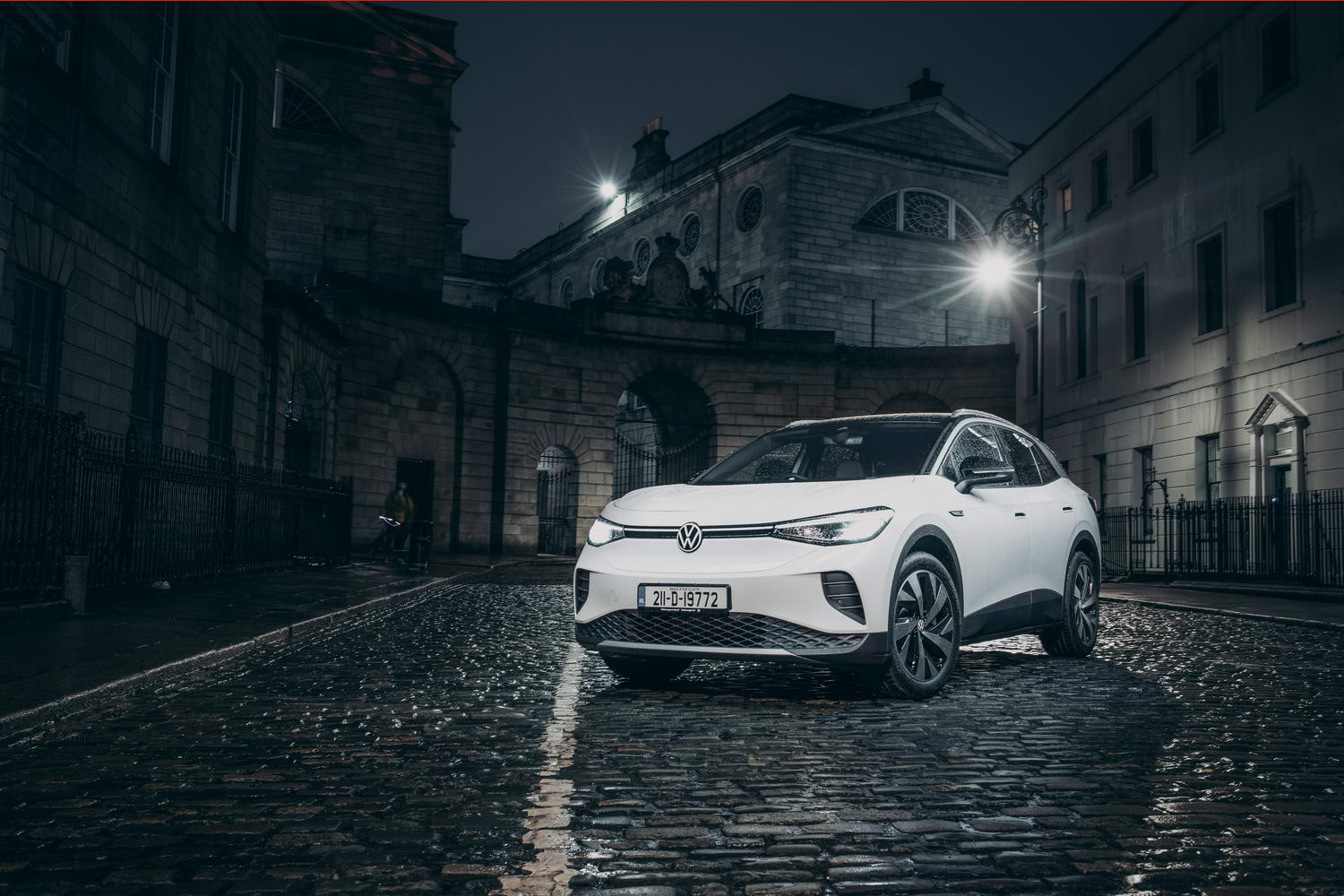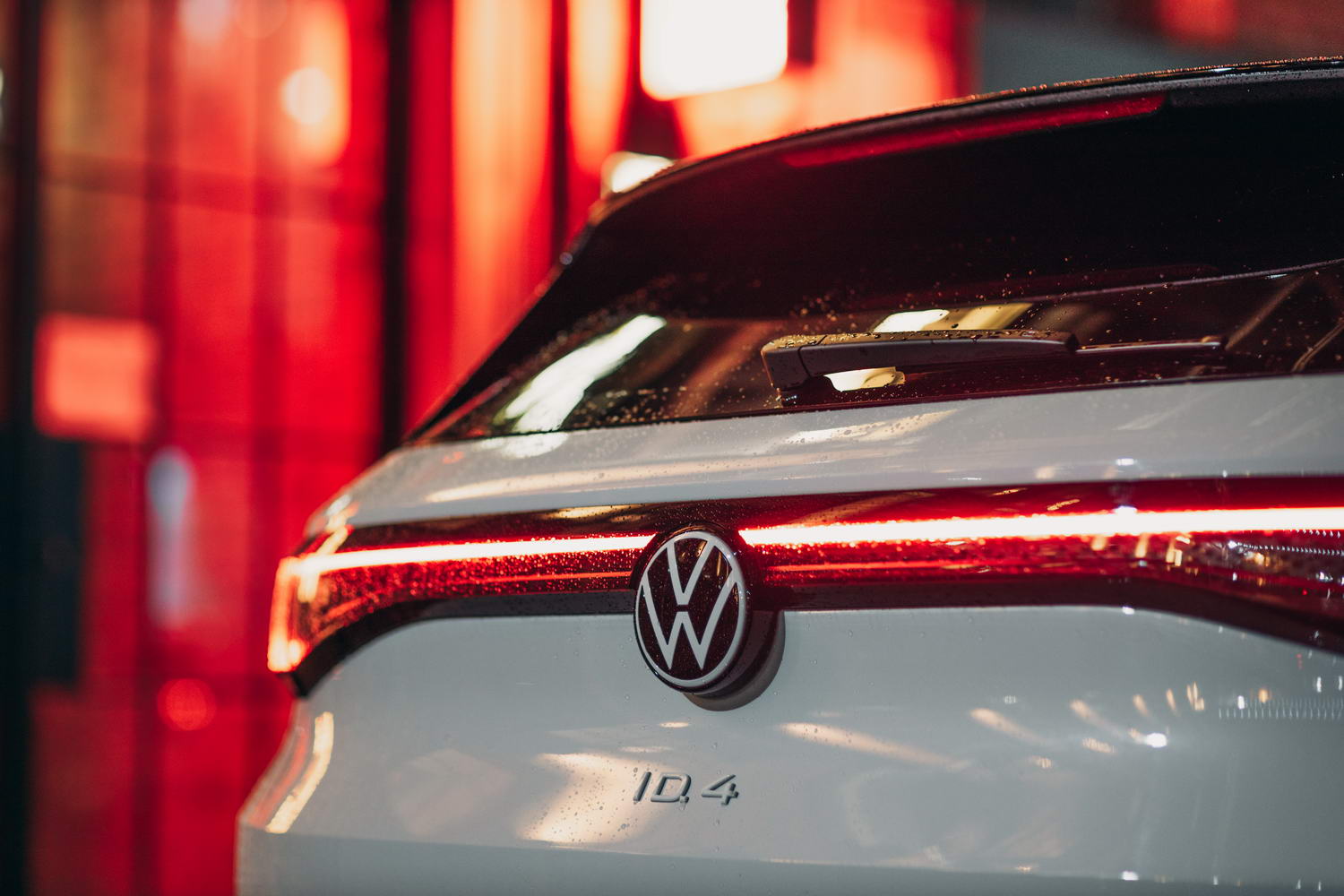Volkswagen ID.4 overview
Ever since Volkswagen announced that it was setting out down an all-electric path - long before legislation compelled it and its competitors to do so - it's arguable that the ID.4 has been its most-anticipated EV product. Well, by those who actually pay their own cash, anyway. While many of us critics got all in a froth about the 'new Beetle!' hype over the smaller ID.3 hatchback, in terms of getting customers in through the dealership door and actually walking out with keys in their hands (or clicking 'order' online), the ID.4 is the one that counts. Given that the combustion engined Tiguan now outsells the venerable Golf in the Irish market, it's all-but-ineluctable that the ID.4 will outsell the ID.3.
Does it deserve to? For all of the ID.3's flaws (mostly to do with software that was, metaphorically, taken out of the oven too early), it's a deeply impressive car, and represents exceptional value for money, especially when arrayed against rival products. The ID.4 is going to have to work hard if it's to truly deserve any best-seller status that comes its way.
The ID.4 arrives armed with a choice of two electric motor power outputs (and a sporty two-motor GTX model on the way), two battery capacities and a broad and sweeping range of individual models and options. It spans a price range from the surprisingly affordable to the comfortably expensive, and also comes with some rather jazzy colour options.
But, is it good enough? Has Volkswagen truly finished it off properly this time, rather than rushing it to market, as it did with the ID.3? And how will it cope with incoming rivals such as the Tesla Model Y and Ford Mustang Mach-E?
The Volkswagen ID.4 model range
Actually, at the base end of the ID.4 model range, its competition is rather less fancy than the Tesla or the Mustang. In fact, the cheapest 148hp ID.4 City model, at €35,436 (including SEAI grant and VRT rebate, for a private buyer) is close to matching high-end versions of the likes of the Peugeot e-2008 and Opel Mokka-e. With its 52kWh battery and 343km WLTP range, the basic ID.4 matches those two on battery size and driving distance, too, but it's a far bigger, roomier, arguably more desirable car than either.
That most basic of ID.4s (and the €39,548 Style model that sits alongside it) use the least powerful motor, have the slower 7.4kW internal charger, and charge at 100kW from a DC rapid charger (not to be sneezed at, actually - with a 52kWh battery, that still represents a quick top-up). Trade up, though, to the ID.4 1st Edition (in which form all of the early-arriving ID.4 models into Ireland have been specified, with a handful of higher-spec ID.4 1st Max versions too) and things get rather more serious. For your €43,423 (including incentives for a private buyer) you now get a 204hp motor (this motor powers all other ID.4 variants), a 77kWh battery, 11kW AC home charging and 125kW DC rapid charging. You also get a range that stretches to a very healthy 519km on a single charge. Just for reference, that's more range than the cheapest Tesla Model 3 saloon, for around €4,000 less.
Once the initial 1st and 1st Max models have been sold, the ID.4 range will then go up through a 77kWh Life model (€44,001); a 77kWh Business (€48,887); a 77kWh Family (€50,365); a 77kWh Tech (€53,995); and a 77kWh Max (not to be confused with the 1st Max, and which retails to private buyers for €57,810). That final Max model sees its range reduced to 507km, thanks to the sheer weight of extra equipment, and larger wheels.
Standard equipment from the basic City model includes 18-inch alloys, a ten-inch infotainment screen, wireless phone charging, a Winter Pack that includes heated seats, centre armrests for front and rear seats, ambient lighting in 30 selectable colours and 60/40 split rear seats.
The 52kWh Style models add 19-inch wheels, Matrix LED headlights, a rear-view camera, keyless entry and ignition, three-zone climate control and tinted rear windows.
The 77kWh Life model gets the faster charging speeds, plus 176km of extra range thanks to the 50 per cent larger capacity battery, while the ID.4 Business gets Matrix LED lights, anti-theft alarm, a rear-view camera and keyless entry. The 77kWh Family model gets a panoramic roof, thermal and acoustic glass and three-zone climate, while the 77kWh Tech model has an 'augmented reality' head-up display, the larger 12-inch infotainment screen, a full suite of active electronic driver aids, powered front seats with a massage function and a powered tailgate. Finally, the top-spec Max comes with all of that plus sports seats, adaptive dampers and a range-saving heat-pump climate control system.
Which all goes to show what good value this ID.4 1st edition that we're testing is - for its €43,423 price tag, you get 20-inch alloy wheels, unique 1st edition badging, metallic paint with a contrast black roof and mirrors, tinted rear windows and a reversing camera.
At the time of writing, Volkswagen has PCP finance offers in play for the ID.4, with a 3.9 per cent APR interest rate and monthly repayments of €379 per month for the basic City (actually on a 5.9 per cent APR); €399 for a Style (on a 4.9 per cent rate); and €489 for a 77kWh Family (that's on the 3.9 per cent rate). Obviously, check out the Volkswagen Ireland website for up-to-date offers.
It's worth remembering that, thanks to being zero-emissions at point of use (and indeed, Volkswagen claims that the ID.4's production and delivery process is 'net carbon neutral') and having a 0g/km CO2 rating, all ID.4 versions cost just €120 per year in motor tax.
The Volkswagen ID.4 interior
For the ID.4 interior, read as per the ID.3 interior, but bigger. And, frankly, better. Thanks to a small charging issue that meant our test ID.4 had to spend an afternoon with our local VW dealer, we spent that same afternoon knocking around in a borrowed ID.3. This is a car with an impressive cabin - roomy, well-made (mostly, anyway), comfortable and practical.
Nonetheless, the ID.4 beats it in pretty much every respect. The basic ingredients are the same as for the ID.3 - the same touchscreen in the centre of the dashboard, which is angled towards the driver and which has the touch-sensitive 'slider' controls for heating and radio volume beneath it. In front of the driver is a neatly-designed steering wheel with the newly-minimalist VW logo at the centre, and behind that is the small, but very clear, instrument display. Conjoined with and to the right of the instrument panel is the small, very tactile, drive selector that you soon get into the habit of simply flicking with an outstretched fingertip to shuffle between D and R.
All of which goes too for the ID.3, but the ID.4 is a far more comfortable place in which to sit. In the ID.3, you feel as if you're sitting up straight at the dining table. In the ID.4, you feel as though you are lounging on a favourite sofa. In fact, I don't think I've driven a large family car with such a laid-back driving position since the original Ford Sierra (remember the 'Sierra Slouch'?).
There's more space than in the ID.3, too, albeit perhaps not so much as you'd like to see - the ID.3 is an impressively roomy car and, given that the ID.4 stretches to more than 4.5 metres in overall length, you might actually reasonably expect a little more lounging room in the back. Still, it's more than adequate, and we doubt many will complain. At the back, there's a very good, flat, and square 543-litre boot, which expands to 1,575 litres with the rear seats down. That's more than adequate for most family needs, but do remember that the sloping line of the ID.4's rear roofline does mean that there's slightly less height for loading in very bulky objects if you're really stretching the car's carrying capacity.
There's an adjustable boot floor, which gives you a flat load-through if you've got the rear seats folded down, albeit at the expense of a little boot depth. There's also the option of a split-panel floor, that allows you to partition off the boot with upright sections - handy for separating muddy sports gear from shopping, for example. It's a shame that the ID.4 (like the ID.3) doesn't come with a 'frunk' storage area under the bonnet, but that's full of radiators and climate control gubbins. There is a small storage area under the boot floor, however, for stashing charging cables and the tyre repair kit.
What really impresses, though, is the ID.4's quality, especially compared to the ID.3. Early ID.3 models seemed to have less-than-stellar cabin finish and fit, and their slightly hard plastics could make the cabin feel a little cold and unwelcoming at times. Not so the ID.4. Here is the kind of lustrous surface quality that we've come to expect from VW (well, mostly - there are some cheaper materials if you go looking for them) and the effect is to make the ID.4's interior feel much richer and more expensive than that of the ID.3. Given the not-massive price gap between the two cars, that could be the thing that clinches more buyers for the 4, even leaving out the current favouritism for SUVs amongst most car buyers.
ID.4 1st models come with a mixture of black and brown upholstery, but you can have the steering wheel finished in an optional contrasting white at no extra cost. It's an interesting touch, but one wonders how well it will cope with stains and marks in later life... You can also have a contrasting brown dash-top, which looks very smart. With no gear selector, there are two large cupholders in the centre console, about where your left hand naturally falls, and a large cubby behind them, with a rolling lid. Even so, we found that those cabin storage areas fill up quickly, once you start filling them with keys, wallets, spare masks, hand sanitiser etc. We do like the slim, sloping space for your smartphone storage though, even if it's not as neat as the upright clip system that Audi uses. There are two USB-C plugs in there too (buy some adaptors, folks...) and another pair for rear-seat passengers.
For those filling their ID.4s with family members, there are two ISOFIX child seat points in the outer rear seats, and one in the front passenger seat - which is actually a little bit of a disappointment. Given that the ID.4 sits on a flat-floored MEB chassis - effectively a clean-sheet design - we do feel that a third, centre-rear, ISOFIX point should have been included in what is a very family-oriented car.
The Volkswagen ID.4 driving experience
Again, and fairly unsurprisingly, the ID.4 feels very similar to the ID.3 to drive. Well, of course it does - the two share the same platform, and consequently they use the same batteries and electric motor. The ID.4, then, has the same liquid-smooth sense of acceleration, and with 310Nm of instant-on torque, step-off performance is enjoyably brisk.
Model-for-model though, the ID.4 weighs around 200kg more than the ID.3, so that initial briskness doesn't last quite so long. That said, performance is entirely fine - 0-100km/h comes up in 8.5 seconds if you really put the hammer down, but far more impressive is the smooth and assured way the ID.4 picks up speed when you're joining a flowing motorway, or pulling into gaps in traffic.
Although the 204hp motor is mounted under the boot floor, and the ID.4 is therefore both rear-engined and rear-wheel drive, VW's engineers have clearly worked hard (more's the pity) to eradicate anything that might suggest, to an average driver, that the ID.4 is anything but a conventional, front-driven, family car. That said, it feels well-balanced, understeering gently and predictably when you push too hard into a corner, and with steering that provides a decent compromise between reassuring weight and ease of use. It's not what you'd call a 'driver's car' but then it's not designed to be - instead, it's capable and sure-footed family transport, and in that role it excels.
The ride quality feels a little more stiff than you'd find in the ID.3 - again, a consequence of the suspension having to be firmed up to deal with the ID.4's weight and its higher centre of gravity - but it's hardly unacceptably so, and if you ditched our test car's 20-inch rims (visually tempting though they are) and went for 19s or 18s, you'd most likely benefit to the tune of greater comfort. Refinement is exceptionally good - obviously, there's no combustion noise, but VW has clearly done its homework when it comes to eradicating tyre and wind noise too. Sitting in lane on the motorway, you could happily and comfortably drive the ID.4 all day long.
And you could do, thanks to the big battery. That 77kWh unit means you can go for a theoretical 520km, and in fact when we collected our test car, with a full charge, the distance-to-recharge was reading a whopping 600km - whoever had it before us must have been driving VERY gently indeed. That 600km figure is unlikely to be replicated in the real world (unless you're only driving around town with helium in your shoes), but the ID.4 has more than enough range for most purposes. Even on long motorway runs, it should do better than 430km before needing to charge, and that's with air conditioning on and the cruise control set to 120km/h.
The regenerative braking system, which ramps up when you stretch out that your finger and flick the gear selector to 'B', is capable of 0.25g of braking force - enough to give the ID.4 'one pedal' driving in urban use, although it's better to leave it in 'D' and let it coast when you lift off on faster roads. When you brake harder, and bring the mechanical brakes into the game, the changeover point is all-but-impossible to detect, and the ID.4 feels well-balanced and secure under a hard stop. Actually, it's only when braking for a tight corner from relatively high speeds that you really notice the weight and bulk of the car - a common issue for EVs with heavy batteries. Overall, we averaged 20kWh/100km energy consumption in our time with the ID.4 - which is pretty good, especially given the amount of motorway driving we did.
When you're charging out and about, it's a good idea to find one of the 350kW IONITY charging points. Volkswagen is part of the consortium of car manufacturers that owns IONITY, and if you sign up for a We Charge Plus Volkswagen charging account, with a €17.99 monthly fee, it trims the cost of charging at an IONITY station from 79c/kWh to 30c/kWh. Unleashing the ID.4's full 125kW DC charging speed means that you'll probably put enough range back into the battery by the time you've queued up for your coffee...
That low-down laid-back driving position, so good for comfort, does mean that the big windscreen pillars cut off a good bit of your forward visibility, and the low, sweeping roofline means that over-the-shoulder visibility isn't that great. Those combine to mean that the rear-view camera is a necessity, and really should be standard rather than optional, and the panoramic roof would be a good choice too for letting in some extra light.
Alternatives to the Volkswagen ID.4
Arguably the biggest competition for the ID.4 comes from within. The ID.3 uses all of the same basic systems, has even better one-charge range (thanks to being a little smaller and lighter), is smaller inside but not by enough to make it in any sense impractical, and costs a little less model-for-model. Really, all that's going against the ID.3 is the less-comfy driving position, and the fact that it's not an SUV.
Tougher competition for the ID.4 could come later this summer in the shape of the Skoda Enyaq iV. The Enyaq uses the same MEB platform, the same 204hp motor, and the same battery pack, but is arguably a little better looking, and being a Skoda will be a little better value, too.
Looking outside the Volkswagen Group, there is of course the Tesla Model Y, which is yet to launch on the Irish market. In extremis, the Tesla will be faster and longer-ranged than the ID.4, but it will also be much pricier model-for-model, and arguably less well-made and reliable. Equally, the upcoming Ford Mustang Mach-E will be sportier to drive, and far sexier to look at, but also pricier.
Our verdict on the Volkswagen ID.4
If you're being really objective, it's slightly hard to justify spending the extra on the ID.4 over the ID.3. However, that statement entirely ignores the emotional aspect of buying a car - for not a lot of extra money, the ID.4 looks like (and to an extent, is) a grander car entirely. Larger, the 'right' shape (at least in the minds of a majority of buyers), with a higher-quality interior and a bigger boot. It's not hard to imagine the ID.4 outselling the ID.3, and rather hard to begrudge it doing so.
What do the rest of the team think?
I liked the early pre-production version of the ID.4 so much that I went ahead and ordered one as our family car. It replaces a Volkswagen Touran in our life (we have three kids, ranging from nearly-six to a 12-year-old) and I disagree with Neil's assessment of the ID.4 vs. the ID.3. We had no desire to own an SUV, but the ID.4 has a huge amount more space in it than the ID.3, making it a fantastic option for our first-ever electric car. I also think it's really good value (away from the top-end of the line-up), making it one of the first EVs that competes on nearly a level playing field with petrol and diesel equivalents. I do wish that Volkswagen hadn't gone 'all in' on the touchscreen and touch-sensitive controls, but otherwise, it's a very good car that I'd thoroughly recommend.
Shane O' Donoghue - Editor

